#Robert Vernay
Explore tagged Tumblr posts
Text
Sur le banc, 1955






La Hurlette et Carmen forment un couple de clochards philosophes, qui goûte de simples plaisirs en compagnie du joyeux Sosthène. Comme dans les contes, La Hurlette apprend qu'il vient d'hériter d'une fortune rondelette pourvu qu'il se trouve un métier. À force de le chercher il y parvient et un banquet réunit les amis déshérités. Décidés à mener la grande vie, La Hurlette et Carmen perdent au casino de Cabourg tout l'héritage et se retrouvent toujours aussi philosophes sur leur banc favori.



#sur le banc#50s#movie#film#cinephile#vcr#vcr aesthetic#vhs#video tapes#blockbuster#french movie#on the bench#Robert Vernay#Raymond Souplex#Jane Sourza#Julien Carette#Nicole Besnard#comedy#1955
0 notes
Text
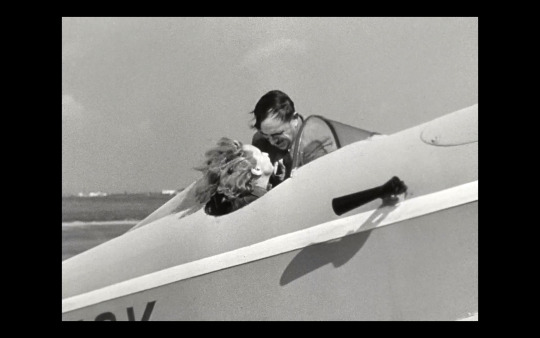

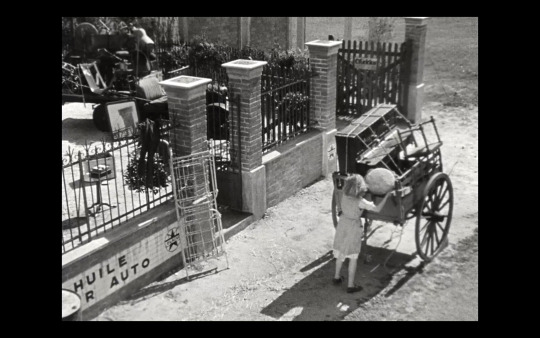
Le Ciel est à vous (The Woman Who Dared)
1944. Romantic Adventure Drama
By Jean Grémillon
Starring: Madeleine Renaud, Charles Vanel, Jean Debucourt, Raymonde Vernay, Léonce Corne, Raoul Marco, Albert Rémy, Robert Le Fort, Anne-Marie Labaye, Michel François, Gaston Mauger, Paul Demange, Henry Houry, Anne Vandène
Country: France
Language: French
#Le Ciel est à vous#The Woman Who Dared#Jean Grémillon#Madeleine Renaud#Charles Vanel#Jean Debucourt#Raymonde Vernay#Léonce Corne#Raoul Marco#Albert Rémy#Robert Le Fort#Anne-Marie Labaye#Michel François#Gaston Mauger#Paul Demange#Henry Houry#Anne Vandène#France#French#1944#1940s#Romance#Adventure#Drama
1 note
·
View note
Text


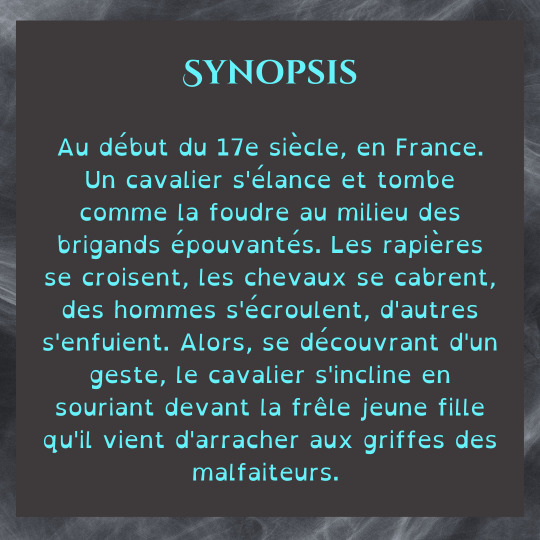
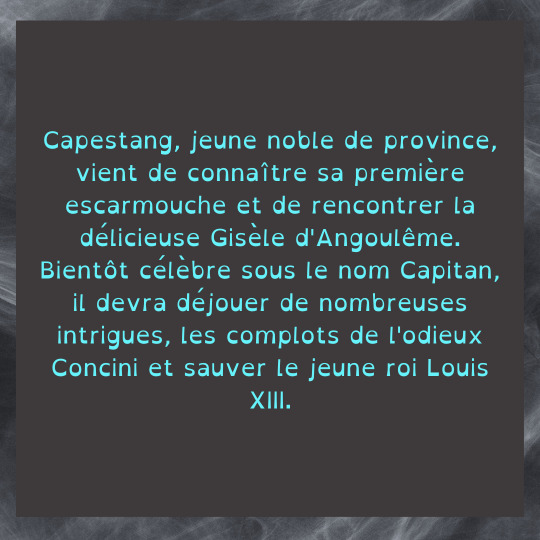
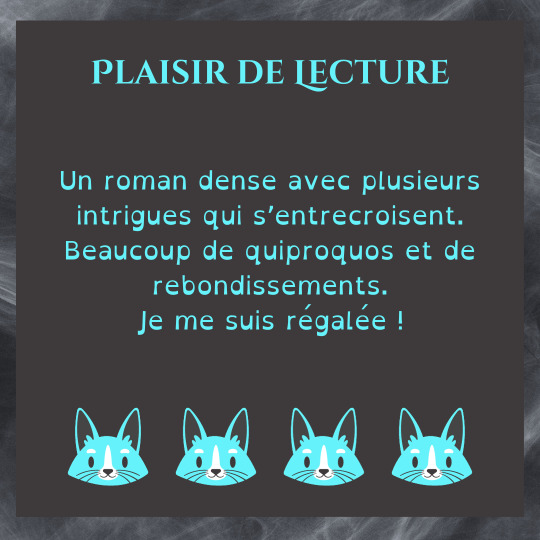

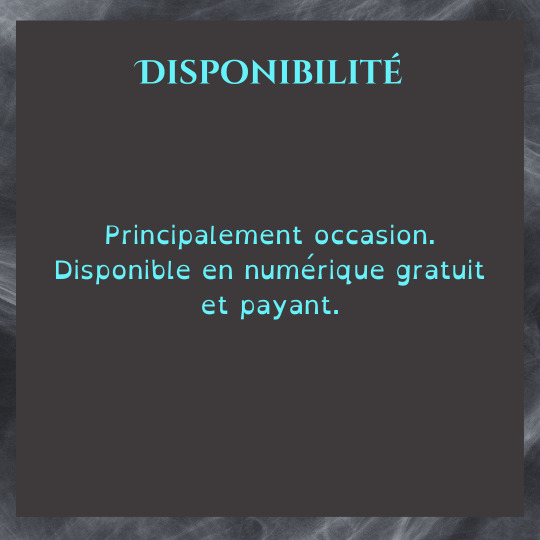
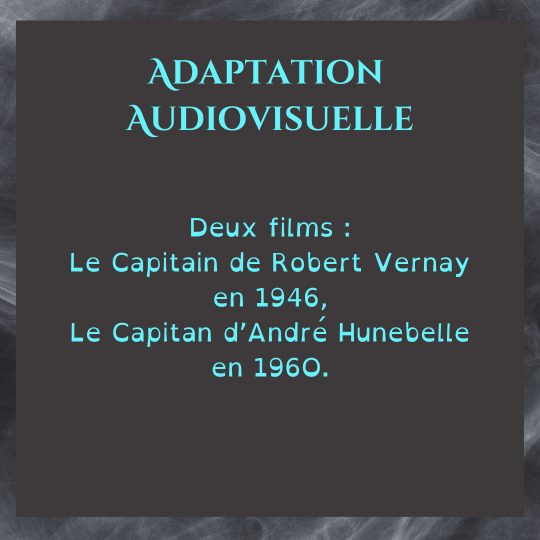

Le Capitan.
Michel Zevaco.
1907.
Synopsis :
Au début du 17e siècle, en France. Un cavalier s’élance et tombe comme la foudre au milieu des brigands épouvantés. Les rapières se croisent, les chevaux se cabrent, des hommes s’écroulent, d’autres s’enfuient. Alors, se découvrant d’un geste, le cavalier s’incline en souriant devant la frêle jeune fille qu’il vient d’arracher aux griffes des malfaiteurs.
Capestang, jeune noble de province, vient de connaître sa première escarmouche et de rencontrer la délicieuse Gisèle d’Angoulême. Bientôt célèbre sous le nom Capitan, il devra déjouer de nombreuses intrigues, les complots de l’odieux Concini et sauver le jeune roi Louis XIII.
Plaisir de Lecture :
Un roman dense avec plusieurs intrigues qui s’entrecroisent. Beaucoup de quiproquos et de rebondissements.
Je me suis régalée !
Note : 4 chats.
Historicité :
Michel Zevaco a pris beaucoup de liberté.
Beaucoup de fantasme autour du duc d’Angoulême et sa famille.
Mais l’ensemble se base aussi sur des faits historiques véridiques.
Disponibilité :
Principalement occasion.
Disponible en numérique, gratuit et payant.
Adaptation audiovisuelle :
Deux films :
Le Capitain de Robert Vernay en 1946,
Le Capitan d’André Hunebelle en 196O.
Bonus Point Chat :
Pas de chats. Snif.
Note : 1 chat.
0 notes
Photo

1954 Polish poster for FACE TO THE WIND (Robert Vernay, France, 1950)
Designer: Waldemar Swierzy
Poster source: Posteritati
94 notes
·
View notes
Photo

Jean Marais Le Comte de Monte-Cristo, Robert Vernay (1954).
21 notes
·
View notes
Text

𝐿𝑎 𝑛𝑜𝑣𝑖𝑎 𝑑𝑒 𝐸𝑠𝑝𝑎𝑛̃𝑎
Empezó en el canto y baile siendo niña, y a los doce años actuó por primera sobre un escenario formando parte de la Compañía de Estrellita Castro, en el espectáculo Rapsodia española. Después se incorporó a las Compañías del Príncipe Gitano y de Paco Reyes.
Su belleza la ayudó a trabajar en muchas películas folklóricas.
Hizo su debut en el cine en 1947 en la película Serenata española, dirigida por Juan de Orduña y tuvo su primer papel protagonista frente a Jorge Negrete en Jalisco canta en Sevilla, dirigida por el mexicano Fernando de Fuentes; participó después en Andalousie (Robert Vernay, 1951).
Protagoniza, entre otras, Cuentos de La Alhambra (1950), de Florián Rey, La hermana San Sulpicio (1952), de Luis Lucia, Violetas imperiales (1952) de Richard Pottier, trabaja en El deseo y el amor (Le désir el l'amour, H. Decoin, id.), La bella de Cádiz (La belle de Cadix, R. Bernard, 1953) y El amor de Don Juan (Don Juan, J. Berry, 1956).
El director español Juan Antonio Bardem le dio un papel en La venganza (1957) (primera película española candidata al Premio Óscar a la Mejor Película de habla no inglesa), después protagoniza Pan, amor y Andalucía (1958) de Javier Setó o El balcón de la luna (1962), junto a Lola Flores y Paquita Rico, pero su fama reconocida en su país natal donde fue la heroína de numerosos melodramas indigentes, además traspasó las fronteras con Aventura para dos (D. Siegel, 1958), Europa di notte (A. Blasetti, 1959), Rey de reyes (Nicholas Ray, 1961, en el papel de María Magdalena), Marco Antonio y Cleopatra (Chalton Heston, 1972 en el papel de Octavia).
𝙵𝚎𝚕𝚒𝚣 𝚌𝚞𝚖𝚙𝚕𝚎 𝟿𝟸!🎂
4 notes
·
View notes
Text
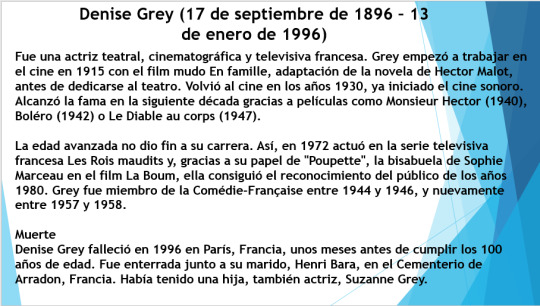





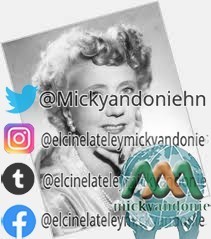
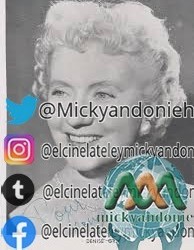
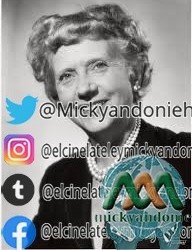
Denise Grey.
Filmografía
Cine
1913 : Mademoiselle Etchiko
1914 : En famille, de Georges Monca
1914 : Madame Rigadin, modiste, de Georges Monca
1914 : Mademoiselle Etchiko, de André Hugon
1914 : Le Voyage de Corbillon, de Georges Monca
1916 : Document secret, de René Navarre
1916 : Nemrod et Cie, de Maurice Mariaud
1916 : Rigadin professeur de danse, de Georges Monca
1917 : Les Bleus de l'amour, de Henri Desfontaines
1917 : Honneur d'artiste, de Jean Kemm
1935 : Jeunes Filles à marier, de Jean Vallée
1936 : La Dame de Vittel, de Roger Goupillières
1937 : Trois artilleurs au pensionnat, de René Pujol
1938 : Trois artilleurs à l'opéra, de André Chotin
1938 : Serge Panine, de Paul Schiller y Charles Méré
1940 : Monsieur Hector, de Maurice Cammage
1941 : Boléro, de Jean Boyer
1941 : Montmartre-sur-Seine, de Georges Lacombe
1942 : Romance à trois, de Roger Richebé
1942 : Le Voile bleu, de Jean Stelli
1942 : Des jeunes filles dans la nuit, de René Le Hénaff
1942 : Retour de flamme, de Henri Fescourt
1942 : L'Honorable Catherine, de Marcel L'Herbier
1943 : Adieu Léonard, de Pierre Prévert
1943 : Vingt-cinq ans de bonheur, de René Jayet
1943 : L'aventure est au coin de la rue, de Jacques Daniel-Norman
1944 : Les Caves du Majestic, de Richard Pottier
1945 : On demande un ménage, de Maurice Cam
1945 : Madame et son flirt de Jean de Marguenat
1945 : L'Insaisissable Frédéric, de Richard Pottier
1945 : L'Extravagante Mission, de Henri Calef
1946 : Étrange Destin, de Louis Cuny
1946 : Le Couple idéal, de Bernard Roland y Raymond Rouleau
1946 : Six heures à perdre, de Alex Joffé y Jean Lévitte
1946 : Coïncidences, de Serge Debecque
1946 : Le Diable au corps, de Claude Autant-Lara
1947 : Et dix de der, de Robert Hennion
1947 : Carré de valets, de André Berthomieu
1948 : Une femme par jour, de Jean Boyer
1948 : Bonheur en location, de Jean Wall
1949 : La Ronde des heures, de Alexandre Ryder
1949 : Tête blonde, de Maurice Cam
1949 : Mon ami Sainfoin, de Marc-Gilbert Sauvajon
1949 : Pas de week-end pour notre amour, de Pierre Montazel
1950 : Rome-Express, de Christian Stengel
1950 : Les Petites Cardinal, de Gilles Grangier
1950 : Demain nous divorçons, de Louis Cuny
1952 : Allô... je t'aime.
1952 : La Tournée des grands ducs, de André Pellenc
1953 : Art. 519 Codice Penale, de Leonardo Cortese
1953 : Il Seduttore, de Franco Rossi
1953 : Raspoutine, de Georges Combret
1953 : Dortoir des grandes, de Henri Decoin
1953 : Les Corsaires du bois de Boulogne, de Norbert Carbonnaux
1953 : Julietta, de Marc Allégret
1953 : Le Père de Mademoiselle, de Marcel L'Herbier
1954 : Escalier de service, de Carlo Rim, sketch Les Béchard
1954 : Le Printemps, l'automne et l'amour, de Gilles Grangier
1954 : Fantaisie d'un jour, de Pierre Cardinal
1954 : Le Mouton à cinq pattes, de Henri Verneuil
1954 : Poisson d'avril, de Gilles Grangier
1955 : La Villa Sans-Souci, de Maurice Labro
1955 : La Rue des bouches peintes, de Robert Vernay
1956 : Sylviane de mes nuits, de Marcel Blistène
1956 : L'Auberge fleurie, de Pierre Chevalier
1956 : Une nuit aux Baléares, de Paul Mesnier
1956 : Mitsou, de Jacqueline Audry
1957 : À pied, à cheval et en voiture, de Maurice Delbez
1957 : Carve Her Name with Pride, de Lewis Gilbert
1957 : La Peau de l'ours, de Claude Boissol
1957 : Le Tombeur, de René Delacroix
1957 : Police judiciaire, de Maurice de Canonge
1957 : Mimi Pinson, de Robert Darène
1957 : C'est la faute d'Adam, de Jacqueline Audry
1958 : À pied, à cheval et en spoutnik, de Jean Dréville
1959 : Bomben im Monte-Carlo, de Georg Jacoby
1959 : Le Confident de ces dames, de Jean Boyer
1960 : Le Panier à crabes, de Joseph Lisbona
1960 : La Française et l'Amour, de Christian-Jaque, sketch Le Divorce
1963 : La Bonne Soupe, de Robert Thomas
1965 : Pas de caviar pour tante Olga, de Jean Becker
1969 : La Maison de campagne, de Jean Girault
1970 : Hello-Goodbye, de Jean Negulesco
1970 : Los Aristogatos, de The Walt Disney Company
1971 : Mais qui donc m'a fait ce bébé ?, de Michel Gérard
1980 : La Boum, de Claude Pinoteau
1982 : La Boum 2, de Claude Pinoteau
1982 : N'oublie pas ton père au vestiaire..., de Richard Balducci
1982 : En cas de guerre mondiale, je file à l'étranger, de Jacques Ardouin
1983 : Le Voleur de feuilles, de Pierre Trabaud
1985 : Le Gaffeur, de Serge Pénard
1988 : Les Saisons du plaisir, de Jean-Pierre Mocky
1991 : Tchin tchin, de Gene Saks.
Televisión
1960 : Rouge, de André Leroux
1962 : Chéri
1967 : Le Chevalier Tempête, de Yannick Andréi
1969 : Tout pour le mieux
1971 : Une autre vie
1972 : Les Rois maudits, de Marcel Jullian y Claude Barma
1977 y 1982 : Cinéma 16
1978 : Un ours pas comme les autres
1979 : Les Moyens du bord
1979 : Les Dames de la côte, de Nina Companeez
1980 : L'Esprit de famille
1983 : Merci Sylvestre
1985 : Les temps difficiles.
Teatro
1916 : Six Hommes, une femme et un singe, de Pierre Veber y Yves Mirande, Théâtre Michel
1921 : Comédienne, de Jacques Bousquet y Paul Armont, Théâtre des Nouveautés
1922 : La Femme de mon ami, Théâtre de l'Athénée
1922 : Atout... Cœur !, de Félix Gandéra, Théâtre de l'Athénée
1924 : Si je voulais..., de Paul Géraldy y Robert Spitzer, Théâtre du Gymnase Marie-Bell
1926 : Passionnément, de Maurice Hennequin y Albert Willemetz, Théâtre de la Michodière
1936 : Europe, de Maurice Rostand, Théâtre Pigalle
1938 : Le Valet maître, de Paul Armont y Léopold Marchand, escenografía de Pierre Fresnay, Théâtre de la Michodière
1948 : Les Enfants d'Edouard, de Frederic Jackson y Roland Bottomley, adaptación de Marc-Gilbert Sauvajon, escenografía de Jean Wall, Théâtre Édouard VII
1949 : Les Enfants d'Edouard, de Frederic Jackson y Roland Bottomley, adaptación de Marc-Gilbert Sauvajon, escenografía de Jean Wall, Théâtre des Célestins
1950 : George et Margaret, de Marc-Gilbert Sauvajon y Jean Wall, escenografía de Jean Wall, Théâtre Daunou
1950 : Il faut marier maman, de Marc-Cab y Serge Veber, escenografía de Pierre Dux, Théâtre de Paris
1953 : Faites-moi confiance, de Michel Duran, escenografía de Jean Meyer, Théâtre du Gymnase Marie-Bell
1955 : Les Enfants d'Edouard, de Frederic Jackson y Roland Bottomley, adaptación de Marc-Gilbert Sauvajon, escenografía de Jean Wall, Théâtre des Célestins
1956 : La Femme du siècle, de Claude Schnerb, escenografía de Jacques-Henri Duval, Théâtre des Célestins, giras Georges Herbert
1959 : Bon Week-End Mr. Bennett, de Paule de Beaumont a partir de Arthur Watkyn, escenografía de Michel Vitold, Théâtre de la Gaîté-Montparnasse
1961 : Ocho mujeres, de Robert Thomas escenografía de Jean Le Poulai.
1962 : Ocho mujeres, de Robert Thomas, escenografía de Jean Le Poulain, Théâtre des Bouffes-Parisiens
1963 : Vénus de Milo, de Jacques Deval, escenografía de Pierre Mondy, Théâtre des Célestins
1965 : Assassins associés, de Robert Thomas, escenografía de Jean Piat, Théâtre Antoine y Théâtre du Palais-Royal
1966 : J'y suis, j'y reste, de Jean Valmy y Raymond Vincy, escenografía de Jean Valmy, Théâtre Marigny
1966 : La Fin du monde, de Sacha Guitry, escenografía de Jean-Pierre Delage, Théâtre de la Madeleine
1967 : Quarante Carats, de Pierre Barillet y Jean-Pierre Gredy, escenografía de Jacques Charon, Théâtre de la Madeleine
1971 : Le Train de l'aube, de Tennessee Williams, escenografía de Jean-Pierre Laruy, Théâtre Édouard VII
1972 : En avant... toute !, de Michel André, escenografía de Michel Roux, Théâtre Édouard VII
1972 : La Bonne Adresse, de Marc Camoletti, escenografía de Christian-Gérard, Théâtre Michel
1973 : La Royale Performance, de Marcel Mithois, escenografía de Jean-Pierre Delage, Théâtre des Bouffes-Parisiens
1974 : Le Tube, de Françoise Dorin, escenografía de François Périer, Théâtre Antoine
1976 : Le Jardin de craie, de Enid Bagnold, escenografía de Raymond Gérôme, Théâtre Hébertot
1977 : Bichon, de Jean de Létraz, escenografía de Jacques Valois, Théâtre de Charleville-Mézières
1978 : Crime à la clef, de Alain Bernier y Roger Maridat, escenografía de Jean-Paul Cisife, Théâtre Tristan-Bernard
1981 : La vie est trop courte, de André Roussin, escenografía de Michel Fagadau, Théâtre Daunou
1983 : La vie est trop courte, de André Roussin, escenografía de Michel Fagadau, Théâtre de la Gaîté-Montparnasse
1984-1985 : Les Temps difficiles, de Édouard Bourdet, escenografía de Pierre Dux, Théâtre des Variétés
1985 : Harold et Maude, de Colin Higgins, escenografía de Jean-Luc Tardieu, Espace 44 Nantes
1987 : Harold et Maude, de Colin Higgins, escenografía de Jean-Luc Tardieu, Théâtre Antoine
1989 : Arsénico y encaje antiguo, de Joseph Kesselring, escenografía de Jean-Luc Tardieu, gira
1991 : La sopera, de Robert Lamoureux, escenografía de François Joffo.
Operetas
1919 : Nelly, de Marcel Lattès, con Félix Oudart (Théâtre de la Gaîté)
1950 : Il faut marier maman, de Guy Lafarge, Théâtre de Paris, con Roland Armontel.
Créditos: Tomado de Wikipedia
https://es.wikipedia.org/wiki/Denise_Grey
#HONDURASQUEDATEENCASA
#ELCINELATELEYMICKYANDONIE
5 notes
·
View notes
Text
Artifact Series J
J. Allen Hynek's Telescope
J. Edgar Hoover's Tie
J. McCullough's Golf Ball
J. Templer's Wind-Up Tin Rooster *
J. C. Agajanian’s Stetson
J.T. Saylors's Overalls
J.M. Barrie’s Swiss Trychels
J.M.W. Turner's Rain, Steam and Speed-The Great Western Railway *
J.R.R. Tolken's Ring
Jack-in-the-Box
Jack's Magic Beanstalk
Jack Daniel's Original Whisky Bottle
Jack Dawson's Art Kit
Jack Duncan's Spur *
Jack Frost's Staff
Jack Kerouac's Typewriter
Jack Ketch's Axe
Jack LaLanne's Stationary Bike *
Jack London's Dog Collar
Jack Parson's Rocket Engine
Jack Sheppard's Hammer
Jack Sparrow's Compass
Jack Torrance's Croquet Mallet
Jack the Ripper's Lantern *
Jackie Robinson's Baseball
Jackson Pollock's "No. 5, 1948"
Jackson Pollock's Pack of Cigarettes
Jackson Pollock's Paint Cans
Jack's Regisword
Jack Vettriano's "The Singing Butler"
Jack's Wrench
Jacob and Wilhelm Grimm's Kinder- und Hausmarchen
Jacob "Jack" Kevorkian's Otoscope
Jacob Kurtzberg's Belt *
Jacqueline Cochran's Brooch
Jacques Aymar-Vernay’s Dowsing Rod
Jacques Cousteau's Goggles
Jacques Cousteau's Diving Suit
Jacques-Louis David's Napoleon Crossing the Alps *
Jade Butterfly
Jadeite Cabbage
Jalal-ud-Din Muhammad Akbar's Smoke Pipe
Jamaica Ginger Bottle
Jaleel White's Hosting Chair
James Abbot McNeill Whistler's Whistler's Mother *
James Allen's Memoir
James Bartley's Britches
James Ben Ali Haggin's Leaky Fountain Pen
James Bert Garner’s Gas Mask
James Bett's Cupboard Handle
James Braid's Chair *
James Brown's Shoes
James Bulger's Sweater
James Buzzanell's Painting "Grief and Pain"
James Buzzanell’s Survey Books
James C. McReynolds’ Judicial Robe
James Chadwick's Nobel Prize
James Clerk Maxwell's Camera Lens
James Colnett's Otter Pelt
James Condliff's Skeleton Clock
James Cook's Mahiole and Feather Cloak
James Craik's Spring Lancet
James Dean's 1955 Prosche 550 Spyder, aka "Little Bastard"
James Dean's UCLA Varsity Jacket
James Dinsmoor's Dinner Bell
James Eads How’s Bindle
James Earl Ray's Rifle
James Fenimore Cooper's Arrow Heads
James Gandolfini's Jukebox
James Hadfield’s Glass Bottle of Water
James Hall III’s Shopping Bags
James Henry Atkinson's Mouse Trap
James Henry Pullen’s Mannequin
James Hoban's Drawing Utensils
James Holman’s Cane
James Hutton's Overcoat
James Joyce’s Eyepatch
James M. Barrie's Grandfather Clock
James M. Barrie's Suitcase
James Murrell's Witch Bottle
James Philip’s Riata
James Prescott Joule's Thermodynamic Generator
James Smithson's Money
James Tilly Matthews’ Air Loom
James Warren and Willoughby Monzani's Piece of Wood
James Watt's Steam Condenser
James Watt's Weather Vane
James W. Marshall’s Jar
Jan Baalsrud’s Stretcher
Jan Baptist van Helmont's Willow Tree
Jane Austen's Carriage
Jane Austen's Gloves
Jane Austen's Quill
Jane Bartholomew's "Lady Columbia" Torch
Jane Pierce's Veil
Janet Leigh's Shower Curtain
Janine Charrat's Ballet Slippers
Jan Janzoon's Boomerang *
Janis Joplin's Backstage Pass from Woodstock *
Jan Karski's Passport
Janus Coin *
Jan van Eyck’s Chaperon
Jan van Speyk's Flag of the Netherlands
Jan Wnęk's Angel Figurine
Jan Žižka's Wagenburg Wagons
The Japanese Nightingale
Jar of Dust from the Mount Asama Eruption
Jar of Greek Funeral Beans
Jar of Marbles
Jar of Molasses from The Boston Molasses Disaster
Jar of Sand
Jar of Semper Augustus Bulbs
Jar of Shiva
Jar of Sugar Plums
Jascha Heifetz's Violin Bow
Jason Voorhese's Machete
Javed Iqbal's Barrel of Acid
Jay Maynard's Tron Suit
Jean II Le Maingre's Gauntlets
Jean Baptiste Charbonneau’s Cradleboard
Jean-Baptiste-Siméon Chardin's Bubble Pipe
Jean Chastel's Silver Gun
Jean Eugène Robert-Houdin's Pocket Watch
Jean Fleury's Aztec Gold Coins
Jean-François Champollion’s Ideographic Dictionary
Jean Froissart's Mirror *
Jean-Frédéric Peugeot's Pepper Mill
Jean Hilliard’s Earmuffs
Jean Parisot de Valette’s Sword Sheath
Jean-Paul Marat's Bathtub
Jean Paul-Satre’s Paper Cutter
Jean-Pierre Christin's Thermometer
Jean Senebier's Bundle of Swiss Alpine Flowers
Jean Valnet's Aromatherapy Statue
Jean Vrolicq’s Scrimshaw
Jeanne Baret's Hat
Jeanne de Clisson's Black Fleet
Jeanne Villepreux-Power's Aquarium
Jeannette Piccard's Sandbag
Jeff Dunham's First Ventriloquist Box
Jefferson Davis' Boots
Jefferson Randolph Smith's Soap Bar
Jeffrey Dahmer's Handkerchief
Jeffrey Dahmer's Pick-Up Sticks
Jemmy Hirst's Carriage Wheel
Jenny Lind's Stage Makeup
Jeopardy! Contestant Podiums
Jerome Monroe Smucker's Canning Jars
Jerry Andrus’ Organ
Jerry Garcia's Blackbulb *
Jerry Siegel's Sketchbook
Jesse James' Saddle
Jesse James' Pistol
Jesse Owens' Hitler Oak
Jesse Owens' Running Shoes
Jesse Pomeroy's Ribbon and Spool
Jester's Mask
Jesus of Nazareth's Whip
Jesús García's Brake Wheel
Jet Engine from the Gimli Glider
Jet Glass Cicada Button
Jethro Tull's Hoe
Jeweled Scabbard of Sforza
Jiang Shunfu’s Mandarin Square
Jim Davis' Pet Carrier
Jim Fixx's Shorts
Jim Henson's Talking Food Muppets
Jim Jones' Sunglasses
Jim Londos' Overalls
Jim Robinson's Army Bag
Jim Thorpe's Shoulder Pads
Jim Ward's Piercing Samples
Jimi Hendrix's Bandana
Jimi Hendrix's Bong
Jimi Hendrix's Guitars *
Jimmie Rodgers Rail Brake
Jimmy Durante's Cigar
Jimmy Gibb Jr's Stock Car
Jimmy Hoffa's Comb
Jin Dynasty Chainwhip
Jingle Harness
Joan II, Duchess of Berry's Dress
Joan of Arc's Chain Mail
Joan of Arc's Helmet (canon)
Joan Feynman's Ski Pole
Joanna of Castile's Vase
Joan Rivers' Carpet Steamer
Joan Rivers' Red Carpet
Joe Ades's Potato Peeler
Joe Girard’s Keys
Joe Rosenthal's Camera Lens
Joel Brand's Playing Cards
Joséphine de Beauharnais' Engagement Ring
Johan Alfred Ander’s Piece of Porcelain
Johann Baptist Isenring’s Acacia Tree
Johann Bartholomaeus Adam Beringer's Lying Stones
Johann Blumhardt's Rosary
Johann Dzierzon’s Beehive Frame
Johann Georg Elser's Postcard
Johann Maelzel's Metronome *
Johann Rall's Poker Cards
Johann Tetzel's Indulgence
Johann Wolfgang von Goethe's Prism
Johannes Brahms' Coffee Creamer
Johannes Diderik van der Waals' Gloves
Johannes Fabricius' Camera Obscura
Johannes Gutenburg's Memory Paper *
Johannes Gutenburg's Printing Press *
Johannes Gutenberg's Printing Press Keys
Johannes Kepler's Planetary Model
Johannes Kepler's Telescope Lense
Johannes Kjarval’s Landscape Painting
John A. Macready's Ray-Bans *
John A. Roebling's Steel Cable
John A.F. Maitland's Musical Brainnumber *
John André’s Stocking
John Anthony Walker's Minox
John Axon's Footplate
John Babbacombe Lee’s Trapdoor
John Bardeen's Radio
John Bodkin Adams’ Stethoscope
John Brown's Body *
John Brown's Machete
John C. Koss SP3 Stereophones
John C. Lilly's Isolation Tank Valve
John Cabot's Map
John Carl Wilcke's Rug *
John Crawley's Painting
John Croghan's Limestone Brick
John Dalton's Weather Vane
John Dee's Golden Talisman
John Dee's Obsidian Crystal Ball
John Dee’s Seal of God
John DeLorean's Drawing Table
John Dickson Carr's Driving Gloves
John Dillinger's Pistol *
John D. Grady’s Satchel
John D. Rockefeller's Bible
John D. Rockefeller, Sr. and Jr.'s Top Hats
John Dwight's Hammer
John F. Kennedy's Coconut
John F. Kennedy's Presidental Limousine
John F. Kennedy's Tie Clip *
John Flaxman's Casting Molds
Sir John Franklin's Scarf
John Gay's Shilling
John Gillespie Magee, Jr.'s Pen
John H. Kellogg's Bowl
John H. Kellogg's Corn Flakes
John H. Lawrence's Pacifier
John Hancock's Quill
John Harrison’s Longcase Clock
John Hawkwood’s Lance
John Hendrix's Bible
John Henry Moore's White Banner
John Henry's Sledge Hammer
John Hetherington's Top Hat
John Holland, 2nd Duke of Exeter's Torture Rack
John Holmes Pump *
John Hopoate's Cleats
John Howard Griffin's Bus Fare
John Hunter's Stitching Wire
John Hunter's Surgical Sutures
John J. Pershing's Boots
John Jacob Astor's Beaver Pelt
John Jervis’ Ship
John Joshua Webb’s Rock Chippings
John Kay's Needle
John Keat's Grecian Urn *
John, King of England's Throne
John L. Sullivan's Boots
John Langdon Down's Stencils
John Lawson's Mannequin Legs
John Lennon's Glasses
John "Liver-Eating" Johnson's Axe
John Logie Baird's Scanning Disk *
John M. Allegro's Fly Amanita
John Macpherson's Ladle
John Malcolm's Chunk of Skin
John Malcolm's Skin Wallet
John McEnroe's Tennis Racket *
John Milner's Yellow '32 Ford Deuce Coupe
John Moore-Brabazon’s Waste Basket
John Morales' McGruff Suit
John Mytton’s Carriage
John Pasche's Rolling Stones Poster Design
John Paul Jones's Sword
John Pemberton's Tasting Spoon
John Philip Sousa's Sousaphone
John Rambo's Composite Bow
John Rykener's Ring
John Shore's Tuning Fork
John Simon's Mouthwash
John Simon Ritchie's Padlock Necklace
John Smith of Jamestown's Sword
John Snow's Dot Map
John Snow’s Pump Handle
John Stapp’s Rocket Sled
John Steinbeck's Luger
John Sutcliffe's Camera
John Sutter's Pickaxe
John Tunstall's Horse Saddle
John Trumbull's "Painting of George Washington"
John von Neumann's Abacus
John Walker's Walking Stick
John Wayne Gacy's Clown Painting *
John Wayne Gacy's Facepaint
John Wesley Hardin's Rosewood Grip Pistol
John Wesley Powell's Canoe
John Wesley Powell’s Canteen
John Wilkes Booth's Boot *
John Wilkes Booth Wanted Poster
John William Polidori's Bookcase
Johnny Ace's Gun
Johnny Appleseed's Tin Pot *
Johnny Campbell's University of Minnesota Sweater
Johnny Depp's Scissor Gloves
Johnny Smith's Steering Wheel
Johnny Weismuller's Loincloth *
Joker's BANG! Revolver
Jon Stewart's Tie
Jonathan Coulton's Guitar
Jonathan R. Davis' Bowie Knife
Jonathan Shay's Copy of Iliad/Odyssey
Jonestown Water Cooler
Jorge Luis Borges' Scrapbook
José Abad Santos' Pebble
José Delgado’s Transmitter
Jose Enrique de la Pena's Chest Piece
Jōsei Toda’s Gohonzon Butsudan
Josef Frings’ Ferraiolo
Josef Mengele's Scalpel
Josef Stefan's Light Bulbs
Joseph of Arimathea's Tomb Rock
Joseph of Cupertino's Medallion *
Joseph Day's Sickle
Joseph Ducreux's Cane
Joseph Dunninger's Pocket Watch
Joseph Dunningers’ Props
Joseph E. Johnston Confederate Flag
Joseph Force Crater's Briefcases
Joseph Fourier's Pocket Knife
Joseph Glidden’s Barbed Wire
Joseph Goebbels' Radio *
Joseph Jacquard's Analytical Loom
Joseph Bolitho Johns’ Axe
Joseph Kittinger's Parachute
Joseph Lister's Padding
Joseph McCarthy's List of Communists
Joseph Merrick's Hood
Joseph-Michel Montgolfier's Wicker Basket
Joseph Moir’s Token
Joseph Pilate's Resistance Bands *
Joseph Polchinski’s Billiard Ball
Joseph Stalin's Gold Star Medal *
Joseph Stalin's Sleep Mask *
Joseph Swan's Electric Light
Joseph Vacher's Accordion
Joseph Vacher's Dog Skull
Joseph Valachi's '58 Chevrolet Impala
Josephus' Papyrus
Joseph Wolpe's Glasses
Josephine Cochrane's Dishwasher
Joshua's Trumpet *
Josiah S. Carberry's Cracked Pot
Joshua Vicks' Original Batch of Vicks Vapor Rub
Josiah Wedgewood's Medallion
Jost Burgi's Armillary Sphere *
Jovan Vladimir's Cross
Juana the Mad of Castiles' Crown
Juan Luis Vives' Quill Set
Juan Moreira’s Facón
Juan Pounce de Leon's Chalice
Juan Ponce de León's Helmet
Juan Seguin's Bandolier
Jubilee Grand Poker Chip *
Judah Loew ben Belazel's Amulet *
Judas Iscariot’s Thirty Silver Coins
Judson Laipply's Shoes
Jules Baillarger's Decanter
Jules Leotard's Trapeze Net
Jules Verne's Original Manuscripts
Julia Agrippa's Chalice
Julia Child's Apron *
Julia Child's Whisk
Julian Assange’s Flash Drive
Julie d’Aubigny's Sabre
Julius and Ethel Rosenberg's Wedding Rings
Julius Asclepiodotus’ Shield Boss
Julius Caesar's Wreath
Julius Wilbrand's Lab Coat Buttons *
Jumanji
Jumper Cables
Junji Koyama’s Vegetables
Jure Sterk's Ballpoint Pen
Jürgen Wattenberg's Leather Provision Bag
Justa Grata Honoria’s Engagement Ring
Justin Bieber's Guitar
Justinian I's Chariot Wheel
Justin O. Schmidt's Wasp Mask
Justus von Liebig's Fertilizer Sack
Justus von Liebig's Mirror
3 notes
·
View notes
Text
Aftermath
October 1, 1918 - Full diary entry:
“The Battle of Argonne.
My first experience in a real push. Our losses were larger than I had thought they would be. The biggest artillery barrage of the war started the battle. We reached our objectives only by hard fighting.
The woods and hills made things harder to get the lay of the land and to realize our position.”
Robert seems to still be reeling from the past several days, and this is his last entry for nearly a week.
There is so much detail documented about these five days that it’s helpful sometimes to take a step back and look at a very concise, objective description of what the 35th Division did. This is from Order of Battle of the United States Land Forces in the World War, Vol. 2, American Expeditionary Forces: Divisions:
Sept 26 - Oct 1, Div participates in the Meuse-Argonne Operation.
Sept 26, Div, on the right of the I Corps, 69th Inf Brig and one battalion 70th Inf Brig, attached, leading, attacks north, captures Cheppy, clears that part of Varennes east of the Aire River, and establishes a line from 1/2 km northwest of Very to the Aire River east of La Forge.
Sept 27-28, Div continues the attack, 70th Inf Brig in line, 69th Inf Brig in support, and captures Charpentry, Baulny, and Chaudron Fme on the first day.
Sept 28, it captures Montrebeau Wood and reaches a line from 1 km northeast of Chaudron Fme, along the northern and western limits of Montrebeau Wood, to l'Esperance.
Sept 29, Div attacks, reaches Exermont and captures the Fme de Beauregard and la N euville-Ie-Comte Fme, north of Exermont Creek, but during the afternoon enemy counterattacks north of Exermont Creek reach the southern edge of Montrebeau Wood, and cause the Div to withdraw to a prepared position on the ridge northeast of Baulny.
Sept 30, Div organizes the line for defense from 1 km northwest of Serieux Fme, toward Chaudron Fme, along the ridge north of Baulny, to the Aire River; 91st Div on the right holds a line within the sector of the 35th Div from a point near the road X km northwest of Serieux Fme to the western edge of the Bois Communal de Baulny; 327th Inf (82d Div) attached to the 28th Div on the left.
Oct 1, 1st Div relieves the Div which assembles in the Very-Cheppy Area.
This map shows how far the 35th reached each day of the battle, but it is far too large and detailed to be viewed in this post. You can see the full map here.

Similarly, this extraordinary map from the Truman Library shows the point where the regiment regrouped after being relieved:

It’s only fitting that the last words on the Meuse-Argonne go to Chaplain Edwards in From Doniphan to Verdun: The Official History of the 140th Infantry:
At three in the morning [on October 1] the First Division made the relief. During the relief we were shelled heavily and continuously, but fortunately escaped with but little loss. The regiment was reorganized and marched to a point south of Cheppy on the Vernays-La Forge road. Fires were started everywhere and the men were able to get warm for the first time in days. The kitchens were soon fired up, and the delightful aromas of cooking food and boiling coffee drifted over the fields...
They looked like tramps. Their faces were covered with a stubble of a week's growth, although some men had managed to shave almost every day, even under fire. The grime had worn into their skin, and they were unbelievably dirty. Their uniforms were soiled and torn, and they were mud to the top of their leggings. There had been a low concentration of gas everywhere, and their eyes were red-rimmed with gas and loss of sleep. But even the gas had not disturbed the cooties. After feeding, they dropped asleep on shelter halves or raincoats, and slept the sleep of utter exhaustion, their silent figures motionless as the dead.
More than half the regiment was missing. But worn out and dirty, there was a strange dignity and strength felt in the regiment. It had met the test. It had passed through fire and blood. Iron had entered its soul. Another action would find them a veteran body of troops, fit for any emergency.
The War Department figures give the following for the 140th: Killed, or died of wounds, 9 officers, 239 men; died of disease or other causes, 1 officer, 94 men; wounded severely, 7 officers and 485 men; wounded slightly, 46 officers, 802 men; wounded, degree unknown, 188 men; total wounded and dead, 63 officers, 1808 men; captured by the enemy, 2 officers and 45 men; total casualties, killed and wounded, not including death from disease, 62 officers, 1714 men; total losses 1823 officers and men. The 140th Infantry had suffered terribly — but it was still a regiment.
Where was Robert today? See the timeline.
Next: Regular Army and National Guard
#wwi#ww1#ww1 on this day#ww1 centenary#140th infantry#35th division#world war one#AEF#Meuse-Argonne#doughboy#diary
1 note
·
View note
Text
NYCC 2017: French Comics Framed Festival returns across the pond to New York Comic Con
#NYCC2017: French Comics Framed Festival returns from across t'pond to @NY_Comic_Con
Break out the croissants! With the best tagline ever dreamed up – ‘French Comics Kiss Better!’ – the FRENCH COMICS FRAMED FESTIVAL, hosted by the French Comics Association, returns to New York Comic Con next month, bringing the creme de la creme of European creators to the event with a whole host of panels, screenings, art parties and more. Many US comics fans may not be too familiar with the…
View On WordPress
#Alex de Campi#Alexis Sentenac#Armando Iannucci#El Torres#Fabien Nury#French Comics Association#Heidi MacDonald#Katie Skelly#Mahmud Asrar#Mathieu Lauffray#New York Comic Con#NYCC 2017#Patricia Lyfoung#Robert Ross Parker#The Death Of Stalin#Thierry Robin#Valérie Vernay#Zep
0 notes
Text
Juillet MMXX
Films
On a volé la cuisse de Jupiter (1980) de Philippe de Broca avec Annie Girardot, Philippe Noiret, Francis Perrin et Catherine Alric
Les Malheurs d'Alfred (1972) de Pierre Richard avec Pierre Richard, Anny Duperey et Pierre Mondy
Spartacus (1960) de Stanley Kubrick avec Kirk Douglas, Laurence Olivier, Peter Ustinov et ony Curtis
La Maison du docteur Edwardes (Spellbound) (1945) d’Alfred Hitchcock avec Ingrid Bergman et Gregory Peck
Angélique, Marquise des anges (1964) de Bernard Borderie avec Michèle Mercier, Robert Hossein et Jean Rochefort
Le Jouet (1976) de Francis Veber avec Pierre Richard, Michel Bouquet, Fabrice Greco, Jacques François et Daniel Ceccaldi
La Malédiction de la Panthère rose (Revenge of the Pink Panther) (1978) de Blake Edwards avec Peter Sellers, Herbert Lom, Dyan Cannon, Burt Kwouk et Robert Webber
Indiana Jones et la Dernière Croisade (Indiana Jones and the Last Crusade) (1989) de Steven Spielberg avec Harrison Ford, Sean Connery, Denholm Elliott et Alison Doody
Le Professionnel (1981) de Georges Lautner avec Jean-Paul Belmondo, Jean Desailly et Robert Hossein
Merveilleuse Angélique (1965) de Bernard Borderie avec Michèle Mercier, Claude Giraud et Jean Rochefort
Bataille sans merci (Gun Fury) (1953) de Raoul Walsh avec Rock Hudson et Donna Reed
Le Chasseur (The Hunter) (1980) de Buzz Kulik avec Steve McQueen, Eli Wallach et Kathryn Harrold
Good Night, and Good Luck (2005) de George Clooney avec David Strathairn, George Clooney, Robert Downey Jr. et Frank Langella
Chapeau melon et bottes de cuir (The Avengers) (1998) de Jeremiah S. Chechik avec Ralph Fiennes, Uma Thurman et Sean Connery
Les Aristochats (The Aristocats) (1970) de Wolfgang Reitherman avec Claude Bertrand, Michèle André, Anne Germain, Roger Carel et Mark Lesser
Les Compères (1983) de Francis Veber avec Gérard Depardieu, Pierre Richard, Michel Aumont et Anny Duperey
Angélique et le Roy (1966) de Bernard Borderie avec Michèle Mercier, Robert Hossein, Estella Blain et Sami Frey
Le Comte de Monte-Cristo (1954) de Robert Vernay avec Jean Marais, Lia Amanda, Roger Pigaut et Jacques Castelot
Spectacle
Le Professeur Rollin a encore quelque chose à dire (2003) de François Rollin
Séries
Top Gear Saison 11, 14, 21, 9, 18, 12, 16, 10, 21, 22, 15
L’art de la chasse - La traversée du Japon - Nostalgie des années 80 - Un train peut en cacher un autre - Made in China - La fiesta dans tous ses états - Hommage à Saab - Course en chasse neige - Patagonie Première partie - Patagonie Deuxième partie - Fiat 500 VS Vélo - Sur les rives du lac de Côme - Mercedes, folle du désert - James VS Tanner - Limousines géantes - Raffinement anglais - Roadsters à 5000 £
The Grand Tour Saison 2, 3
Passé, présent ou avenir ? - Coup de vieux - Jaaaaaaaags - Bagages et vintage - Oh oui, de l'essence - Mozambique - Aston, astronautes et les enfants d’Angelina
Chapeau Melon et Bottes de Cuir Saison 4
Dans sept jours, le déluge - L'Heure perdue - La Poussière qui tue - Avec vue imprenable
Commissaire Dupin
Un cadavre disparaît
Kaamelott Livre VI, IV
Præceptores
Maguy Saison 1
Tu me trompes ou je me trompe ? - Comment boire sans déboires
Hero Corp Saison 1
Le Village - Le Test
Dancing on the edge
Pilot - Papillon de nuit
Nestor Burma Saison 2
Du rébecca rue des Rosiers
Livres
Histoire des rois de Bretagne de Geoffroi de Monmouth
OSS 117 : Angoisse pour OSS 117 de Jean Bruce
0 notes
Text
#gallery-0-5 { margin: auto; } #gallery-0-5 .gallery-item { float: left; margin-top: 10px; text-align: center; width: 33%; } #gallery-0-5 img { border: 2px solid #cfcfcf; } #gallery-0-5 .gallery-caption { margin-left: 0; } /* see gallery_shortcode() in wp-includes/media.php */
Starke Junioren im Audi R8 LMS in der DMV GTC
Phoenix Racing beim Heimspiel mit dem Audi R8 LMS GT4 vorn
Bislang stärkstes Rennwochenende für Andreas Wernersson im Audi RS 3 LMS
Audi Sport customer racing erlebte mit seinen Kunden ein weiteres gutes Wochenende: Der Audi R8 LMS erreichte in der Rennserie DMV GTC auf dem Nürburgring seinen fünften Sprintsieg und seinen zweiten Langstreckensieg. Auch der Audi R8 LMS GT4 und der Audi RS 3 LMS fuhren am Wochenende Siege und weitere Pokale ein. Audi R8 LMS GT3 Starke Junioren: Das vierte Rennwochenende der DMV GTC stand im Zeichen mehrerer Junioren. Simon Reicher gewann das Dunlop-60-Rennen auf dem Nürburgring im Audi R8 LMS. Der 19 Jahre alte Österreicher feierte mit dem sächsischen Audi-Kundensportteam Yaco Racing in dem 60-Minuten-Rennen im Alleingang seinen ersten Sieg. Es war der zweite Saisonsieg für den Audi R8 LMS in einem Dunlop-60-Rennen. Platz drei ging an Vincent Kolb. Der 24 Jahre alte Frankfurter pilotierte einen Audi R8 LMS von Phoenix Racing. In den anschließenden Sprintrennen sammelten die Kunden von Audi Sport weitere Pokale. Uwe Alzen gewann im Audi R8 LMS das erste Rennen der DMV GTC. Für den früheren Profi war es bereits der vierte Sprintsieg, der Audi R8 LMS hat bislang fünf von acht Rennen der Breitensport-Serie gewonnen. Simon Reicher komplettierte mit dem dritten Platz im ersten Rennen und Rang zwei im zweiten Lauf sein exzellentes Wochenende. Der Spanier Isaac Tutumlu Lopez erreichte mit Car Collection Motorsport in einem weiteren Audi R8 LMS zudem den dritten Platz im zweiten Rennen. Podestplätze in Zhuhai: Beim zweiten Lauf des Pan Delta Super Racing Festival fuhr die Zun Motorsport Crew zwei Podiumsplätze ein. Lin Yiming aus China erreichte im Audi R8 LMS in beiden Läufen den dritten Platz. Debüt für bahnbrechende Entwicklung: Ein Audi R8 LMS diente als Basis für den ersten Rennwagen ohne Lenksäule. Die Schaeffler Paravan Technologie GmbH & Co KG präsentiert in Zusammenarbeit mit Phoenix Racing das erste Modell dieser Art, das vom Deutschen Motor Sport Bund (DMSB) zugelassen ist. Audi Sport-Pilot Markus Winkelhock wird den Rennwagen künftig in der Rennserie DMV GTC pilotieren. Seine Premiere erlebt der Technologieträger beim 24-Stunden-Rennen auf dem Nürburgring: Die Projektpartner präsentieren den Audi R8 LMS am Freitag, 21. Juni, um 16 Uhr im Phoenix-Shop auf dem ring°boulevard. Einen Tag später dreht der Rennwagen unmittelbar vor dem 24-Stunden-Rennen seine erste Runde auf der Nordschleife des Nürburgrings.
Audi R8 LMS GT4 Zwei Siege und ein zweiter Platz: Phoenix Racing gelang auf dem Nürburgring ein gutes Heimspiel mit dem Audi R8 LMS GT4. Beim vierten Rennwochenende der DMV GTC setzten sich der Däne Nicolaj Møller Madsen und der Schweizer Cédric Freiburghaus in der Klasse 5 bestens ins Szene. Gemeinsam dominierten sie ihre Klasse im Dunlop-60-Rennen und verschafften sich im Lauf einer Rennstunde mit Fahrerwechsel 21,9 Sekunden Vorsprung. Anschließend starteten sie individuell: Nach Platz zwei von Møller Madsen im ersten Sprint beendete Freiburghaus das Wochenende mit einem Sieg vor drei weiteren Konkurrenten im zweiten Sprint. Audi RS 3 LMS (TCR) Zweiter Saisonsieg in Skandinavien: Andreas Wernersson steigerte seine gute Form in der TCR Scandinavia am dritten Rennwochenende nochmals. Der Junior aus dem Team Brink Motorsport fuhr zum ersten Mal in dieser Saison im Qualifying die Bestzeit und sammelte dafür bereits fünf Punkte. Das erste Rennen in Skellefteå gewann er im Audi RS 3 LMS in einem Fotofinish mit 22 Tausendstelsekunden Vorsprung vor Robert Dahlgren. Es war sein zweiter Saisonsieg. Im zweiten Rennen fiel Wernersson nach einem Ausritt auf den letzten Platz zurück, kämpfte sich aber wieder bis auf den dritten Platz vor. An seinem bislang besten Rennwochenende sammelte der Audi-Privatier 45 Punkte und rückte damit um eine Position auf Platz zwei der Tabelle vor. Sechs Punkte trennen ihn von Tabellenführer Robert Dahlgren. Das Team Brink Motorsport bleibt weiterhin an der Spitze der Teamwertung. Erster Saisonsieg in Brasilien: Henry Visconde gelang in der Rennserie Endurance Brasil im dritten Lauf der erste Klassensieg der Saison. Der Vorjahres-Divisionssieger teilte sich den Audi RS 3 LMS mit Tiel de Andrade und Julio Martini. Nach drei Rennstunden gewannen sie auf dem Kurs von Santo Cruz do Sul im Süden von Brasilien ihre Klasse. Platz zwei in Zhuhai: Filipe Souza verpasste einen Sieg beim zweiten Lauf der Circuit Hero One Series in China denkbar knapp. Der Rennfahrer aus Macau führte das Rennen im Audi RS 3 LMS von der Pole-Position 13 Runden lang an. Ein schleichender Reifenschaden aber ließ Souza zwei Runden vor Schluss keine Chance. Am Ende überquerte er die Ziellinie als Zweiter. Podium in Monza: Das italienische Kundenteam BF Motorsport erreichte beim vierten Rennwochenende der Coppa Italia einen Podiumsplatz. Edoardo Barbolini fuhr im ersten von zwei Sprints auf dem Kurs von Monza im Audi RS 3 LMS auf den zweiten Platz der TCR-Wertung und war damit bester Teilnehmer in der TCR-DSG-Klasse. WTCR – FIA-Tourenwagen-Weltcup: Am kommenden Wochenende starten die vier Audi Sport-Piloten Niels Langeveld, Gordon Shedden, Jean-Karl Vernay und Frédéric Vervisch zur Halbzeit der Saison 2019 am Nürburgring auf der längsten Strecke im Kalender. Die 25,378 Kilometer lange Kombination aus Nordschleife und Grand-Prix-Kurs lag dem Audi RS 3 LMS im Vorjahr gut. Vervisch erreichte einen zweiten und einen dritten Platz und begann damit in der Eifel eine Serie von sieben Podiumsergebnissen im Verlauf von acht Rennwochenenden. Auch in diesem Jahr absolviert der Belgier das Doppelprogramm aus FIA WTCR im Audi RS 3 LMS und 24-Stunden-Rennen im Audi R8 LMS. Neben den jeweils zwei Rennwagen des Comtoyou Team Audi Sport und des Leopard Racing Team Audi Sport steht erstmals in diesem Jahr ein fünfter Audi RS 3 LMS in der Startaufstellung der FIA WTCR. Der Finne Antti Buri, aktuell Tabellenführer in der ADAC TCR Germany, nimmt mit dem Team AS Motorsport als Wildcard-Nennung an den drei Rennläufen teil. Termine der nächsten Woche 20.–22.06. Nürburgring (D), 5. und 6. Lauf Audi Sport Seyffarth R8 LMS Cup 20.–24.06. Nürburgring (D), 24-Stunden-Rennen 21.–22.06. Nürburgring (D), 13. bis 15. Lauf WTCR – FIA-Tourenwagen-Weltcup 21.–03.06. Tailem Bend (AUS), 2. Lauf GT-1 Australia 21.–23.06. Imola (I), 3. und 4. Lauf Campionato Italiano GT Sprint 21.–23.06. Imola (I), 5. und 6. Lauf TCR Italy 22.–23.06. Donington (GB), 7. und 8. Lauf British GT Championship 22.–23.06. Suzuka (J), 5. und 6. Lauf Blancpain GT World Challenge Asia 22.–23.06. Smolenskring (RUS), 5. und 6. Lauf TCR Russia 22.–23.06. Sugo (J), 3. und 4. Lauf TCR Japan 22.–23.06. Valencia (E), 3. Lauf Campeonato de España de Resistencia 22.–23.06. Sydney (AUS), 3. und 4. Lauf CAMS NSW Production Sports Car Championship 22.–23.06. Banja Luka (BIH), 7. Lauf FIA CEZ – Ende –
Quelle: Audi Motorsport
Siege für den Audi R8 LMS auf dem Nürburgring Starke Junioren im Audi R8 LMS in der DMV GTC Phoenix Racing beim Heimspiel mit dem Audi R8 LMS GT4 vorn…
0 notes
Text
Sous l’Occupation, le cinéma français, qui connait un surprenant essor, recueille quelques-uns de ses plus grands triomphes, et voit apparaitre une nouvelle génération d’auteurs de talent.
Les Enfants du paradis de Marcel Carné d’après un scénario de Jacques Prévert (1945) avec Arletty, Jean-Louis Barrault, Maria Casarès, Pierre Brasseur, Marcel Herrand, Pierre Renoir
Dernier Atout de Jacques Becker (1942) avec Raymond Rouleau, Mireille Balin, Pierre Renoir, Georges Rollin, Noël Roquevert, Jean Debucourt
Lumière d’été de Jean Grémillon (1943) avec Madeleine Robinson, Paul Bernard, Madeleine Renaud, Pierre Brasseur
L’Éternel Retour de Jean Delannoy (1943) avec Jean Marais, Madeleine Sologne, Jean Murat
En dépit des contraintes idéologiques et économiques et de la tutelle vigilante de la censure – et après une année 1941 plutôt hésitante – le cinéma français va connaître dès 1942 un prodigieux essor. Après trois ans de silence, Carné et Prévert présentent au public un conte médiéval énigmatique, glacial et raffiné, Les Visiteurs du soir (1942), histoire d’un amour plus fort que la mort et que le diable (l’inoubliable Jules Berry, méphistophélique à souhait) vient troubler. Le metteur en scène et le scénariste n’ont certainement pas prévu que leur œuvre deviendrait le manifeste d’une renaissance du cinéma français. Et pourtant leur film, même s’il a vieilli aujourd’hui, va rendre espérance et dignité à un art national au moment où le besoin s’en faisait le plus sentir. Ils ouvriront la voie à Cocteau et Delannoy : L’Eternel Retour (1943), transposition moderne du mythe de Tristan et Iseut, sera un grand succès.
La production se poursuit
Confirmant ce renouveau, on pourrait citer au moins deux films fantastiques fort intéressants, La Main du diable (1942), de Maurice Tourneur et Le Baron fantôme (1942), de Serge de Poligny, où joue Cocteau, qui signe les dialogues. On doit également à Poligny La Fiancée des ténèbres (1944), que l’on ne découvrira qu’après la Libération, de même que La Cage aux rossignols (1944), de Jean Dréville. Mentionnons encore un drame très noir d’Albert Valentin, Marie-Martine (1942), dont le scénario et les dialogues sont dus à Jean Anouilh. Avec son chef-d’œuvre, Douce (1943), féroce satire sociale qui sera censurée, Autant-Lara fait mieux que tenir les promesses du Mariage de Chiffon (1941) et de Lettres d’amour (1942). D’autres metteurs en scène vont pouvoir poursuivre leur œuvre sans rencontrer trop d’obstacles. Sacha Guitry (qui sera arrêté en 1944 sous l’accusation de collaboration malgré son refus de travailler pour la Continental) affirme son talent d’acteur-réalisateur dans deux films romantiques comme Le Destin fabuleux de Désirée Clary (1942) et La Malibran (1943), ou dans un sujet contemporain avec Donne-moi tes yeux (1943). Abel Gance dédie au maréchal Pétain Vénus aveugle (1941), qu’il fait suivre d’une adaptation trop raisonnable du Capitaine Fracasse (1942). Avec six films en quatre ans, Christian-Jaque reste l’un des cinéastes les plus prolifiques de l’Occupation ; si Carmen (1943) n’offre pas grand intérêt, La Symphonie fantastique (1942), consacrée à la vie de Berlioz, n’est pas sans qualités ; sur un scénario de Mac Orlan, Voyage sans espoir (1943) ressuscite avec bonheur le réalisme poétique d’avant-guerre. Mais son œuvre la plus marquante sera Sortilèges (1944), Ce curieux film, dont Prévert a écrit le scénario, ne sortira qu’après la Libération. Avec six films également, la carrière d’Henri Decoin s’annonce aussi féconde. Outre Premier Rendez-vous (1941) et Les Inconnus dans la maison (1942), il faut retenir L’Homme de Londres (1943), une autre adaptation de Simenon, avec une bonne reconstitution d’atmosphère. Les deux premiers films d’André Cayatte, La Fausse Maîtresse (1942) et Au Bonheur des dames (1943) sont respectivement adaptés de Zola et de Balzac. Puis c’est Pierre et Jean (1943), beaucoup plus réussi, inspiré de l’œuvre de Maupassant.
Le Baron fantôme de Serge de Poligny (1942) avec Odette Joyeux, Jany Holt, Alain Cuny, André Lefaur, Gabrielle Dorziat
La Main du diable Maurice Tourneur (1942), inspiré de la nouvelle de Gérard de Nerval, La Main enchantée. Avec • Pierre Fresnay, Josseline Gaël, Noël Roquevert, Guillaume de Sax, Pierre Larquey
La Cage aux rossignols de Jean Dréville (1945) avec Noël-Noël, Micheline Francey, Georges Biscot, René Génin
Douce de Claude Autant-Lara (1943) avec Odette Joyeux, Roger Pigaut, Madeleine Robinson, Marguerite Moreno
Le Mariage de Chiffon de Claude Autant-Lara (1942) avec Odette Joyeux, André Luguet, Jacques Dumesnil
Le Destin fabuleux de Désirée Clary de Sacha Guitry (1941) avec Sacha Guitry, Jean-Louis Barrault, Aimé Clariond
Vénus aveugle d’Abel Gance (1941) avec Viviane Romance, Georges Flamant, Henri Guisol
La Symphonie fantastique de Christian-Jaque (1942) avecJean-Louis Barrault, Renée Saint-Cyr, Lise Delamare
Voyage sans espoir de Christian-Jaque (1943) avec Jean Marais, Simone Renant, Paul Bernard
PREMIER RENDEZ-VOUS – Henri Decoin (1941) – Danielle Darieux, Fernand Ledoux, Louis Jourdan, Gabrielle Dorziat
Les Inconnus dans la maison d’Henri Decoin (1942) avec Raimu, Juliette Faber, Jean Tissier, Jacques Baumer, Noël Roquevert
Pierre et Jean d’André Cayatte (1943) avec Renée Saint-Cyr, Noël Roquevert, Jacques Dumesnil
Clouzot, Becker, Bresson
Au sein de la nouvelle génération d’auteurs qui apportent alors un souffle nouveau au cinéma français, trois grands noms se détachent : Clouzot, Becker et Bresson. Clouzot a fait ses débuts de réalisateur avec un policier, L’assassin habite au 21 (1942), une réussite honorable. En 1943, il va réaliser le film qui restera sans doute son chef-d’œuvre, Le Corbeau, l’une des œuvres qui marquera le plus profondément cette époque par son pessimisme amer et violent. En même temps que Clouzot, Jacques Becker fait également ses débuts avec un policier, Dernier Atout (1942). Un film extrêmement brillant qui connaît un vif succès commercial. Cet ancien assistant de Renoir adopte un style réaliste où se mêlent les influences du cinéma français d’avant-guerre et du film policier américain. Avec Goupi mains-rouges (1943), il s’essaye avec bonheur à la fresque paysanne dans le goût naturaliste. Quant à Falbalas (1944), achevé au moment de la Libération ce sera le premier film de sa célèbre série de « sujets parisiens». Dès sa première œuvre, Les Anges du Péché (1943), Robert Bresson se révèle comme un investigateur subtil et racinien de l’âme humaine, avec le concours précieux d’un dialoguiste de génie : Jean Giraudoux. S’affirmant dès lors comme l’un des plus authentiques créateurs du cinéma français, il poursuit son éblouissante carrière, toujours en solitaire avec Les Dames du bois de Boulogne (1944), une adaptation austère d’un épisode de « Jacques le Fataliste» de Diderot, avec des dialogues de Cocteau.
L’assassin habite au 21 d’Henri-Georges Clouzot (1942) avec Pierre Fresnay, Suzy Delair, Jean Tissier, Pierre Larquey, Noël Roquevert
Le Corbeau d’Henri-Georges Clouzot, sorti en 1943 avec Pierre Fresnay, Ginette Leclerc, Pierre Larquey, Micheline Francey
Falbalas de Jacques Becker (1945) avec Raymond Rouleau, Micheline Presle, Jean Chevrier
Goupi Mains Rouges de Jacques Becker (1943) avec Fernand Ledoux, Georges Rollin, Blanchette Brunoy
Les Anges du péché de Robert Bresson (1943) avec Renée Faure, Jany Holt, Sylvie, Silvia Monfort, Louis Seigner
Les Dames du bois de Boulogne de Robert Bresson (1945) avec Maria Casarès, Élina Labourdette, Paul Bernard
Félicie Nanteuil de Marc Allégret (1945) avec Claude Dauphin, Micheline Presle, Louis Jourdan
Au Bonheur des Dames d’André Cayatte (1943) tiré du roman d’Émile Zola avec Michel Simon, Albert Préjean, Blanchette Brunoy, Suzy Prim
Les Visiteurs du soir de Marcel Carné (1942) avec Arletty, Alain Cuny, Marie Déa, Jules Berry
En attendant la Libération
Jean Grémillon poursuit une œuvre qui reste dans la meilleure tradition du « réalisme poétique ». Si Lumière d’été (1942), vigoureux acte d’accusation contre l’hypocrisie des classes dirigeantes, inquiète la censure, Le ciel est à vous (1943), qui exalte l’héroïsme désintéressé d’un couple d’aviateurs, sera considéré comme le symbole des valeurs nationales – aussi bien par Vichy que par la Résistance. Il faudrait encore citer l’excellent Comte de Monte-Cristo (1942) en deux époques, de Robert Vernay, ou l’inégal Léo Joannon avec Le Camion blanc (1942) et Le Carrefour des enfants perdus (1943), qui révéla Serge Reggiani. Ou encore L’aventure est au coin de la rue (1943), de J. Daniel-Norman, qui sera l’un des derniers grands succès de l’Occupation. Il serait également injuste d’oublier deux films de Marc Allégret, Félicie Nanteuil (1942) et Lunegarde (1944). A la Libération s’achève enfin le tournage des Enfants du paradis, la réussite sans doute la plus exemplaire de cette époque. 220 films, 82 réalisateurs, dont 20 débutants, tel est le bilan positif du cinéma français d’août à juillet 1944.
1940-1945 : Un essor surprenant Sous l'Occupation, le cinéma français, qui connait un surprenant essor, recueille quelques-uns de ses plus grands triomphes, et voit apparaitre une nouvelle génération d'auteurs de talent.
#abel gance#andré cayatte#christian jaque#claude autant lara#henri decoin#henri georges clouzot#jacques becker#jean dréville#Jean Grémillon#marc allégret#marcel carné#maurice tourneur#robert bresson#sacha guitry
1 note
·
View note
Text
TCR: Coronel e Huff debutteranno nella International Series a SPA-Francorchamps
I veterani delle corse turismo, Tom Coronel e Robert Huff, debutteranno nella TCR International Series partecipando al week-end di gara a SPA-Francorschamps Rob Huff si unirà al Team WRT per la restante parte della stagione della TCR International Series. Sarà il compagno di team di Jean-Karl Vernay e guiderà la seconda Volkswagen Golf GTI TCR del team Leopard. Huff ha provato la vettura nella…
View On WordPress
0 notes
Text
78) A lifetime’s secret revealed at last.
I have a confession to make. Something I have bottled up for 50 years and more. One of those dirty secrets that dare not speak its name. Stand by to be shocked.
I. Like. Musicals.
There. I’ve said it. Phew..blimey….you just don’t know what a relief that is.
And now that I’ve finally got that much out, I’d better get it all off my chest.
When I was seventeen, the film of the Rodgers and Hammerstein musical, ‘The Sound of Music’ came out - to coin a phrase - and I went to see it about five times. At least.
I remember going on my own to the Regent Cinema by the Clock Tower in Brighton to revel in my guilty pleasure. I had a crush on Charmian Carr, who played the eldest Von Trapp daughter, Lisl - as in ‘I am sixteen, going on seventeen’.
It was the beginning of the end of the era of the musical and people of my generation were definitely not supposed to like them. They represented everything that the baby boomers were determined to reject.
It was 1965, and the Beatles and Stones and Dylan were all up and running - and I with them. In 1964, my last year at Brighton Grammar School, I used to sit next to a chap called Phil Sutton for GCE history and most ‘lessons’ were spent arguing about whether the Stones or the Beatles were better. He was an early Stones fan, I was with the Beatles. At the time it seemed impossible, but I was living proof it was possible to like both ‘she was just seventeen, well, you know what I mean’ AND ‘you are sixteen going on seventeen’.
Not that I would ever had admitted that to Phil.
The wilderness years.
At best, musicals were thought us of camp and quaint. At worst, as silly and saccharine and hopelessly out of date, and, damned to hell by that most scathing of put-downs - uncool.
Although fast withering on the vinyl, it wasn’t quite the end of the musical. At least two of the very best came after - ‘Oliver’, 1968, and ‘Cabaret’ 1972. And every so often, there was an exception to the rule that musicals were cinematic history - ‘Chicago’, ‘The Rocky Horror Picture Show’, ‘Sweeney Todd’, ‘Mama Mia’ come to mind. (Though ‘Mama Mia’, because it was a juke-box musical, doesn’t really count for me.)
There were, too, Milos Forman’s version of ‘Hair’, a film that seems to have been largely forgotten but which I remember as liking a lot; and ‘Fame’ and ‘Evita’ which had their moments; and ‘Grease’ which was a million times repeated joy for my daughter if not for me; and, more recently, ’Les Miserables’ which, with its silly operatic pretensions and monotonous dirgey music proved there is always an an exception to every rule - it was the one musical I really, really didn’t take to.
But when you consider the vast number of films pumped out in the nearly half a century since the sixties, the musical as a Hollywood species, if not exactly endangered, was rarely spotted, and, during that long winter, those of us who secretly loved them have had to be very, very careful not to be caught saying so for fear of being thought of as crazy or weird or worse, gay. (For a bloke, admitting to liking musicals has been particularly difficult. They have been seen not just as unfashionable, but almost unmanly.)
Click here to drop jaw.
But adore them I secretly did. My absolute favourite piece of film ever is Donald O’Connor singing ‘Make ‘Em Laugh’ from ‘Singin’ In The Rain’. Pure untrammelled genius. https://www.youtube.com/watch?v=SND3v0i9uhE I defy you to watch this and not be awestruck. I have counted only nine ‘cuts’ in this piece of film of well over four minutes of the most complicated, intricate dancing and slapstick comedy. I wonder what it must have been like to have been there on the set to witness, ‘live’, such astonishing virtuosity.
Watch too, the movement of the camera - panning along, tracking in and out, jibbing up and over. Each movement must have involved several people working on camera equipment much cruder than we have today; everything and everyone as perfectly and painstakingly rehearsed as the performance they were shooting. And then these two halves - performers on one side of the camera and crew on the other - fitting together to make a seamless, stunning whole.
‘My Fair Lady’, ‘West Side Story, ‘Damned Yankees’, and all those Fred and Ginger musicals on telly, I lapped them all up. And I always loved almost any Rodgers and Hammerstein musical - ‘Oklahoma’, ‘Carousel’, ‘South Pacific’. At the heart of any musical has to be the music and the music was magical. ‘Oh What a Beautiful Morning’, ‘June is Busting Out All Over’, ‘Surrey with the Fringe on Top’, ‘A Cockeyed Optimist’…To me, they are all gems, wonderful hummable tunes with with witty, tricky lyrics that fit that them so perfectly they feel as though there could never have been any alternative.
And every so often the songs in musicals are are more than just hummable and witty; they can, occasionally, be truly profound. Not for the first time in BloggerBlagger I refer you to the scarily stirring and simultaneously horrifying ‘Tomorrow Belongs to Me’ from Cabaret. https://www.youtube.com/watch?v=29Mg6Gfh9Co
La La Land to the rescue.
Despite all this great stuff, for all these years it simply hasn’t been okay to admit to being a fan of the musical.
I remember going to the NFT not so long ago to see a screening of ‘Kiss Me Kate’, Cole Porter’s 1953 work of wonder. (If you think I am exaggerating check out ‘Brush up your Shakespeare’ - https://www.youtube.com/watch?v=bPduoU826ew) Post modern irony was all the rage and I got really hacked off at a couple of smart-arses sitting behind me who were clearly of the mind that it was okay to laugh at the film but not with it. Twats, I thought, pathetic.
But the truth is I was no better than the rest. That I have framed this piece as a confession, albeit supposedly ironically, is proof of that.
And, of course, what gives me permission to now confess is ‘La La Land’. Suddenly it seems post-modern irony is dead and in post-post-modernism it is okay to admit to liking a musical. The musical is, believe it or not, almost cool.
I say ‘almost’ because I think some of the supposed backlash to the critical enthusiasm for ‘La La Land’ has been the reaction of people who can’t quite get their heads around the idea that, after decades of being programmed to dismiss musicals as being embarrassingly passé, they are now supposed to embrace them.
Not that I am without the odd nagging doubt myself. Although, broadly speaking, I liked ‘La La Land’, and grateful as I am for its crucial role in bringing the musical back into the zeitgeist, I do have some issues with it. The singing and dancing are manifestly not in the same league as in the good old days, and the music, though pretty enough, is unlikely to make into the great American songbook.
I have read that the flaws in technique - Ryan Gosling is very obviously no Fred Astaire - were deliberate, or, at least, that perfection was never the intention. In a sense, or so I believe the theory goes, the amateurishness is an essential part of the updating of the form; that a Marni Nixon would never have been asked to redub Emma Stone’s singing (à la Natalie Wood in West Side Story) because in 2017 the authenticity is what makes it work. I have to say it is a theory that I don’t quite understand and that, personally, I would have preferred it if Ryan’s dancing had looked a little more fluid.
However I refuse to countenance any criticism of Emma Stone, no matter how tremulous her voice. I fell for her completely and utterly.
*Charmian Carr, move over.
*(A possibly inappropriate expression since she died last year.)
POST SCRIPT
Since I wrote this, a couple of readers (Dawn Culmer and Allan Gold) have pointed out a couple of glaring omissions of mine from the pre-sixties period, ‘Guys and Dolls’ and ‘High Society’. Click here to see what I missed,
https://www.youtube.com/watch?v=g6Umq4dK95c
And
https://www.youtube.com/watch?v=7kq1JQUhwVQ
Footnote on the rest of the Oscars
In 2014, ’12 Years a Slave’, you will remember, won the best picture Oscar. There was never any doubt that it would. It had built up a critical head of steam through the year, told a story - the horrendous capture and re-enslavement of a previously freed black man - that was bound to engage the sympathy of any awards voter, and was directed not by some tainted-by-trade ex-commercials director like J C Chandor but by Steve McQueen, not just a movie director but an actual bone fide artist who had won the Turner Prize. It ticked every box.
I saw it at the London Film Festival in late 2013 and privately had my doubts - very impressive in parts, but some wooden dialogue, an unconvincing cameo by producer Brad Pitt as the only good white guy in it, and an oddly sanitised version of New York in the early 19th century.
Still the awards tide was running in its favour and it was never going to be denied. ‘All is Lost’ the brilliant and effectively word-free Robert Redford one- hander about a lone yachtsman in crisis, a truly original piece, which was written and directed by the aforementioned JC Chandor in the same year, didn’t make it on to any Oscar awards shortlist at all except for 'sound editing'. Talk about being damned by faint praise.
The next year came Ava du Vernay’s ‘Selma’, another film about black issues and for my money a far superior one. I hate it when audiences clap at the end of films - seems absurd when there’s no-one to take a bow - but when John Legend’s closing song ‘Glory’ played I was so moved I really wanted to applaud. If you haven’t seen ‘Selma’ you should. David Oleweyo does a fantastic turn as Martin Luther King. But it didn’t win and I never thought it would. Two ‘black ‘ films were never going to carry off the Oscar in successive years. (The chorus of the song goes, ‘One day when the glory comes, it will be ours.’ Sadly not for Ava, not just a black director but a black woman director.)
Then last year came the furore over the 2015 Oscars being almost exclusively white. And this year, at least partly as a reaction to that, the pendulum predictably swung back the other way and no few than four films dealing with American racial issues were in the running in one category or another - ‘Moonlight’, ‘Loving’, ‘Hidden Figures’ and ‘Fences’.
Of these, the one that received the least attention, ‘Loving’ - a best actress nomination for Ruth Negga was all it got - impressed me the most. Fascinating story, superb, restrained acting and noticeably fine photography. ‘Moonlight’, on the other hand, which famously received the Oscar for Best Picture after the great presentation debacle, left me pretty cold - as I saw it, a thin story that took a painfully long time to tell. As a tale of a young man coming to terms with his homosexuality, I thought ‘Brokeback Mountain’ beat it into a cocked hat. (To coin another phrase.) Without all the Oscar fuss, I doubt more than three people outside London would have seen 'Moonlight’ in the Ukay. Now there will be a few thousand more, most of whom will leave the cinema scratching their heads.
Kenneth Lonergan, who wrote and directed ‘Manchester By The Sea’ looked to me distinctly unimpressed that his effort hadn’t won the big prize. Can’t say I blame him. It most definitely should have.
(If your life is so impoverished that you really have nothing better to do you, you can listen to a podcast of two of my erstwhile colleagues from Colourful Radio and I discussing the Oscars at length. The level of debate will probably go a long way to explaining why we got chucked off. https://soundcloud.com/jammiemedia/sets/the-oggscars-2017 )
0 notes








